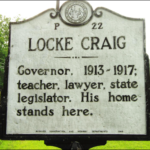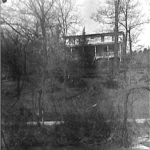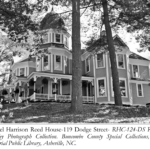Hurricane Helene Recovery and Resources
Technical Support
Free technical support is available for any structures over 50 years old in Buncombe County that were impacted by Hurricane Helene! Whether you need a second opinion, a contractor recommendation, help reviewing contractor assessments, assistance with appealing red tag status, or recommendations on best materials and practices for rebuilding, we are here to help. Please give our office a call at (828) 254-2343 or email jessie@psabc.org to request technical assistance.
Surveys
Survey work is underway to assess damage to historic structures in Buncombe County. Learn more about our survey work here.
Preservation Grants Available
In light of Hurricane Helene, preservation grants from $500 – $5000 are currently available in the category of Brick-and-Mortar. The following are some guidelines for this current grant cycle (see grant application below).
- There is currently no grant application deadline and applications will be reviewed as we receive them. Send applications to grants@psabc.org.
- If you need a generator and/or dehumidifiers to mitigate water damage in a historic structure, immediate assistance will be considered without the need to apply for a grant. Please make your request directly to jessie@psabc.org
- The current focus of grants will be for properties roughly 50 years or older that have been affected by hurricane Helene, with special priority placed on helping keep people in their homes.
- In order to apply for our funding we ask that you also be taking the steps necessary to take advantage of insurance and FEMA funding.
- While we are using our existing grant application, please feel free to adjust as necessary for the current conditions. We will accept and review all applications regardless of how complete they are and reach out for any additional information.
Historic Preservation as Recovery
By Annie Rubel
Founder, Heritage Emergency Management, Inc.
Recovery is a long-term project, but the comradery and care that you have seen bloom and amplify across the city and the region is the resource that cannot be raised, loaned, or donated. Take heart and be kind to yourselves—
We know from numerous studies that the recovery of cultural heritage is essential for communities to recover from disasters—psychologically, spiritually, and financially. From our museums and historic sites to our historic places of worship, to the historic neighborhoods and culture districts that give our towns their unique identities and appeal—Historic Preservation is itself a tool for recovery, not just a priority or goal. The whole cultural heritage field has a deeply significant role to play after disasters, but for the purposes of this article, I would like to speak to historic property owners who are about to, or are already in the midst of stabilizing, repairing, and restoring their buildings.
Emergency Management, as you have all become too familiar with, is best understood as a cycle. There are “phases”= Mitigation, Preparedness, Response, Recovery. But these are cyclical and cannot be seen as a linear process. They can also run parallel and concurrently. So, as you embark upon recovery, it is important to consider mitigation and preparedness in your plans and efforts. Some refer to this as building back better. It is a matter of boosting resilience and being strategic in decision-making.
Understandably, we just want to get back to normal life, clear the mud, get rid of the evidence, as quickly as possible. But we can risk doing more harm if we move too quickly and don’t have a solid plan. In historic preservation, with historic structures, it is even more important to document, assess, prioritize, and ensure we are working with the best information and decision-making in place.
Slow Down, a challenging but wise approach
A general rule of thumb with historic buildings is you want to make changes and decisions slowly. This may go against our instincts, but historic buildings want us to take our time. We must act quickly to stop the source of damage, secure a building envelope, get air flowing, and stabilize the most at-risk elements, but once these steps have been taken, step back. We can do more harm than good when we use brute force (or direct heat or sandblasting!) to rescue historic structures.
Carefully document and assess damage, then determine what can be salvaged and what must be discarded. Err on the side of preservation—things often look worse than they are, and good decisions are very hard to make until elements and materials are dry and clean. Water-damaged wood floors, for instance, can settle and flatten with some time even if they seem totally ruined at first. A metaphor, but also a material truth.
When we go slowly, we also increase our ability to take advantage of more funding sources and access to professional expertise. Otherwise, we miss opportunities to make longer-term strategic decisions that boost resilience and make our money go further.
In the most practical and immediate ways, going slowly can include setting an alarm to take breaks, drink water, get a snack, and regularly check in with a friend or colleague throughout the day. This prevents injury, mistakes, and unnecessary losses. But in a broader sense, we must see ourselves in this moment as ushering in a new chapter in the building’s history. It’s the beginning of a marathon process and windows can be repaired as long as we don’t chuck them at the first sign of rot.
Take the time to create systems and plans. Document everything you do—before touching or changing things, during, and after. Record and track where things are going as you salvage and move belongings and pieces of buildings around. Create a data logging system to ensure you are keeping track of your windows, doors, books, heirlooms. Even better, form a team and dish out roles and responsibilities—stay consistent.
And this cannot be overstated—in a disaster, whether personal or community-wide, we are not ourselves. We are not thinking as clearly as we do under other circumstances, as clear as that may or may not be. You may notice you are clumsier, foggier, jumpier, less cooperative and quicker to frustration—this is all very natural and should be acknowledged and honored. Giving ourselves as much time to make decisions as possible will lead to better decision-making and a healthier recovery.
[Only you can] Prevent Secondary Disasters…
Unfortunately, secondary disasters are common during recovery efforts. These range from worksite injuries to theft or vandalism to major structural fires. There are simple ways to eliminate or mitigate these risks by taking clear preventative steps. This is another example of why taking the time to plan is so critical.
Note: Even experienced contractors need to think through these things more explicitly than usual when it comes to historic buildings. Notre Dame was being renovated by a very experienced, highly skilled company when it caught fire. But especially after disasters, we are often DIYing or working with volunteers, and are not firing on all cylinders, so do not miss the chance to actively manage these risks.
For example:
Are you working on a building that is surrounded by abandoned structures? If so, consider security risks and the greater need for reliable communication if you were to require help.
Are you working on a building where windows have been boarded up and the HVAC system isn’t functional? If so, consider how you will keep the building ventilated both for the safety of you and anyone working in the building and to prevent the build-up of moisture, vapor, or gas.
Are you working around unknown hazards? Consider having the soil, air, or water tested through a remediation, environmental monitoring, or occupational health and safety company. You can’t properly protect yourself if you do not know the hazards.
Are you working with volunteers or as a family? Designate someone who must be responsible for all people on site. Make sure everyone knows who this person is and that they are dedicated to ensuring the safety and wellbeing of everyone working, including keeping track of who is onsite. If that person has to leave, ensure they transfer the responsibility to another person before leaving.
Fire risk during historic building renovations
According to studies conducted after the fire at Notre Dame de Paris in 2019, around 80% of fires in historic buildings occur during renovation or restoration activity. Despite the assumption that it is often due to the carelessness of workers, this appears to be untrue and is not a helpful way to look at the risk. It is likely more commonly attributed to seemingly innocuous things such as leaving tool batteries charging overnight. Usually when things go awry, there are numerous sources of risk and a series of compounding vulnerabilities, but there are a few easy ways historic building owners can lower (mitigate) their risk of fire during renovation and restoration projects.
Note: You certainly want to lower the risk of fire, but you also want to improve the chances of firefighters being able to quickly access the building to fight any fires that may occur. Keep this access in mind, especially to the building itself and to the attic/roof system.
- Unplug all extension cords, tools, and battery chargers at the end of each workday or during breaks if no one will be onsite.
- Ensure all extension cords are heavy-duty and rated for construction. Ensure they are in good condition and you are not running cords longer than is safe.
- Store trash and debris properly. Remove from site as frequently as possible. Do not leave trash or debris piled up inside or against structures.
- Keep all tools and materials organized, out of pathways, and secure from unauthorized people. If you find yourself stepping over things or zigzagging throughout the day, reconsider the way your worksite is laid out.
- Store all chemicals properly and dirty/oily rags in a fire-proof waste container.
- Keep roads, driveways, and pathways to the building as clear as possible even if this means storing materials in a less than convenient location.
- If there is no power to the building, still ensure that there are battery-powered smoke detectors and carbon monoxide alarms to alert people onsite to these common hazards.
- When using generators, truly take the time to read the directions and understand how to safely use the equipment. It is the cause of so many fires and injuries. Don’t take this for granted.
These steps will also reduce the risk of worksite injuries, chemical spills, and other emergencies.
Building first aid/first response:
Though this phase may have passed for most people within the context of Hurricane Helene, this could be relevant at any moment and is a helpful reference in the future. It applies to major disasters, but also things as common as burst pipes. We don’t need the worst to occur to benefit from emergency management principles.
Assuming the building has been cleared by first responders and all occupants have been accounted for, if applicable, follow this Checklist before entering the building:
- Do you have a partner? Do not enter a damaged space alone.
- Are utilities shut off as necessary? Double check.
- Do you have the proper PPE? Seriously.
- Do you have a reliable form of communication or a plan for contact?
- Do you have a way to document? Pens, paper, phone, etc.?
- Do you have a plan? Don’t start a project or phase without a plan.
Plan, then communicate about your plan, then plan again.
- Create a plan:
- What is your objective? Ensure this is achievable and take things in bite sized pieces.
- What and who will you need to achieve this?
- How will you acquire those needed resources?
- How will you determine when you have achieved the objective?
- Make sure everyone understands the objective and knows the plan.
- Enact plan.
- Debrief, reflect, and prepare for next phase with a new plan!
Note: I do this when hosting a dinner party, so you can bet I do this when embarking on a building rescue project.
The nitty gritty, concrete, must do, please note, follow this:
Note, some of these steps can be flipped around to a degree but keep the general structure in place.
- Document and record all damage before moving things or intervening. You will need this for insurance purposes, but also because it is unlikely you will remember much in the emotional and adrenaline-filled moment.
- Secure the building envelope—tarp over large openings in walls or roof damage. 90-lb rolls of roofing paper is better than nothing and Tyvek or other building wrap can be effective on wall openings.
- Ventilate the building as soon as possible and get the drying process started—open windows and doors, create air movement by using fans and dehumidifiers if possible.
- Use air filters in your windows to keep unwanted dust and hazards from entering the building. Using at least MERV 8 furnace filters in windows will provide helpful air filtration.
- Keep in mind that with air movement, you can spread hazards and contaminants around. Consider how to filter these or contain them such as putting plastic between rooms, closing off vents, etc.
- Use dehumidifiers, but not whole-building desiccant dehumidification. The ideal humidity level is relative to temperature. In general, though, a good range for humidity after a water event, depending on temperature, is between 30%-50% in a residential setting to prevent mold growth (this does not take creature comfort into account). Museums and buildings with artifacts are best kept between 40%-60%.
- Note: It is possible to over-dry a building and to dry a building too quickly, which can damage historic materials.
- Stop to assess and prioritize. After immediate stabilization, you have bought yourself time to stop and put plans together. You will not be able to do everything, so get strategic and intentional.
- Do not pick anything up until you know where you will put it down.
- Make sure you have designated a safe place to put salvaged things—plan for this. Taking the time to establish this holding or triage area will save you time in the long run, so don’t skip this step.
- Designate a place for trash and debris away from the building, not blocking driveways or paths.
- Create a documentation and tracking process so you can stay organized.
- Separate contaminated objects from uncontaminated ones—wet away from dry, moldy away from clean, etc.
- Properly dispose of wet or contaminated insignificant* materials such as insulation, drywall/sheetrock, carpets.
- *Do not dispose of meaningful or significant things until they are dry and you have determined if they are salvageable—you may be surprised how much is salvageable and it is worth taking your time on making those decisions even if things look bleak. We often lose more than we need to in a hasty clean-out, muck-out process.
- If possible, rinse mud and debris off architectural elements and belongings while still wet.
- Use the most non-invasive cleaning methods possible—avoid harsh chemicals, sandblasting, power-washing at high settings, scrapers, etc. until you have the chance to do research or engage a technical specialist.
- Salvage and retain architectural features such as interior wood, plaster elements, windows, doors, etc. These are much more salvageable than you may believe, and it makes historic buildings more resilient to damage than contemporary ones.
- If you have access to a freezer, freezing wet objects, particularly most types of paper, can buy you time to salvage those items by suspending the deterioration. A link to “Salvage at a Glance” as well as “Saving Family Heirlooms” is provided at the end of this article.
In summary, there is hope in systems and procedures. When we are faced with enormity and chaos, generally two things can happen: we freeze, or we go into “hero” mode and can cause injury or damage if we’re not focused on our objectives and planning for risk management. We will never know what we have spared ourselves from or how much worse it could have been without this planning, but we all want to make sure we’ve done whatever is in our power. Our work will always be imperfect, but by learning and considering these principles, we can limit our risks and mitigate our losses…and hopefully find healing along the road to recovery.
For guidance and support in developing Emergency Preparedness and Disaster Response plans for your families, businesses, or institutions, contact Annie Rubel at arubel@heritageemergencymanagement.com
Historic Building Resilience
By Amanda Moore, AIA
Director of Preservation, Preservation Society of Asheville and Buncombe County
When we think of the main threats to our historic buildings, we typically think of deterioration, development, and demolition. But our historic buildings are routinely and increasingly threatened by natural disasters. As we all saw in the days and weeks following Hurricane Helene, many of our historic buildings and neighborhoods have significant damage from flooding, wind, falling trees, and mudslides. Many of these historic buildings have survived past floods and hurricanes because historic building materials are often naturally more resistant to rot and water damage than many modern building materials, but as the storms are becoming more intense and increasing in frequency, steps can be taken to make our historic buildings more resilient.
Preservationists across the country are seeking the best way to maintain a building’s historic character while combating the negative impact natural disasters have on historic buildings. As the leader of developing standards and guidelines for preservation work, the National Park Service in 2019 developed the text for The Secretary of the Interior’s Standards for Rehabilitation and Guidelines on Flood Adaptation for Rehabilitating Historic Buildings, which was expanded in 2021 to the current guidelines. These guidelines were produced in response to requests for technical preservation guidance specific to historic properties that are at risk of flooding.
In North Carolina, a team of individuals from North Carolina State University and the University of North Carolina at Chapel Hill with support from the North Carolina State Historic Preservation Office and Department of Natural and Cultural Resources came together to develop the Historic Resilience Project. The project seeks to equip the local communities throughout North Carolina with resources to address the natural threats to our historic buildings. The Historic Resilience Project includes three inter-related resources:
- The Historic Resilience Primer, a general introduction for North Carolina communities
- The Community Planning Handbook, a guide for community conversations and prioritization
- The Resilience Design Standards, model design standards for historic resilience
While the Resilience Design Standards have not been officially adopted by Asheville’s Historic Resources Commission, there have been ongoing conversations to adopt them.
The thought of repairing and rehabilitating our historic buildings after such an unprecedented disaster can be overwhelming, but when you are ready, these standards can provide guidance on how to rebuild in a more resilient way. PSABC is here to help you now and in the future to develop resilience strategies for your historic property.
Resources
The Secretary of the Interior’s Standards for Rehabilitation and Guidelines on Floor Adaptation for Rehabilitating Historic Buildings – https://www.nps.gov/orgs/1739/upload/flood-adaptation-guidelines-2021.pdf
North Carolina Historic Resilience Project – https://hrp.sog.unc.edu/




